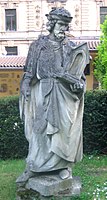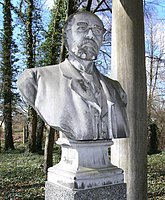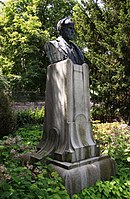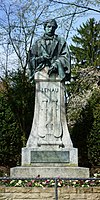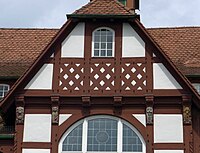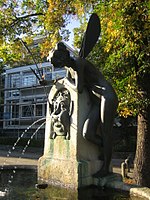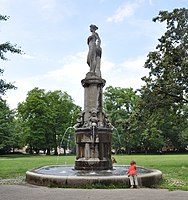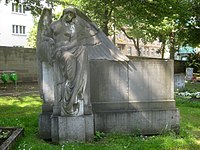Emil Kiemlen
Emil Kiemlen (born January 15, 1869 in Cannstatt , † August 15, 1956 in Stuttgart ) was a German sculptor and painter who lived and worked in Stuttgart.
In a classical language of forms, sometimes animated with Art Nouveau elements, he created numerous small sculptures, including a statuette of the dancer Saharet and the centerpiece “Siegfried”, as well as secular and sacred sculptures that have largely been preserved. Popular fountains in Stuttgart (Junobrunnen, Dragonfly Fountain, Froschbrunnen) show the artist from his cheerful side.
Life
Emil Kiemlen was the son of the tobacco merchant Friedrich Kiemlen. He attended secondary school in Stuttgart and enjoyed his first training as a chaser under the medalist Rudolf Mayer , who worked as a teacher at the Stuttgart School of Applied Arts from 1874 to 1886, then in Munich under the goldsmith and chaser Adolf Halbreiter . From 1891 to 1894 he studied sculpture with Adolf von Donndorf at the Stuttgart Art Academy and in 1897 at the Académie Julian in Paris under Denys Puech . From 1898 he worked as a freelance sculptor in Stuttgart and the surrounding area.
Emil Kiemlen died on August 15, 1956 at the age of 87 in Stuttgart. His urn was buried in the Uff churchyard in Stuttgart-Bad Cannstatt. Posterity has almost forgotten Kiemlen, although many of his works have been preserved in Stuttgart and the surrounding area, although the name of their creator is largely unknown.
plant
After his return from Paris, from 1898 onwards, Kiemlen created a series of small sculptures in a short period of time, which “found justified recognition at all major art exhibitions”. He "adopts the classicistic design language of his teacher Adolf von Donndorf, which he occasionally revives with Art Nouveau elements from around 1900". At the Paris World Exhibition in 1900 , the Great Berlin Art Exhibitions and the annual exhibitions in the Munich Glass Palace , he was represented with the statuettes Saharet, Elegy, Reue, Escape, Witch and Ball Player. The graceful bronze figure of the famous dancer Saharet shows her with a fluttering robe and floating on the tip of one foot. The centerpiece "Siegfried", made in the Heilbronn silverware factory Peter Bruckmann , shows the triumphant Siegfried as a victorious dragon slayer on a dragon with widely spread wings.
Until the 1920s, Kiemlen created secular and sacred architectural sculptures in public spaces, including numerous statues, portrait busts and reliefs for buildings, fountains, tombs and monuments, and after the First World War also war memorials. The Junobunnen, the dragonfly fountain and the frog fountain in Stuttgart also show Kiemlen from his cheerful side. From 1930 onwards only a few works were created in public spaces.
List of works
![]() Map with all coordinates of the section list of works : OSM
Map with all coordinates of the section list of works : OSM
| → Column legend and sorting | |
|---|---|
| Location | |
| Sorting | |
| image | year | place | Location | object |
|---|---|---|---|---|
| ? | Stuttgart-West |
Municipal Lapidarium , Mörikestrasse 24 |
Statue of the Ulm minster builder Matthäus Böblinger , originally on the corner of Breitscheidstrasse and Büchsenstrasse in Stuttgart, after the Second World War in the municipal lapidarium (inventory number 110). | |
| 1895? | Heilbronn |
Main cemetery |
Tomb of the industrialist family Knorr with the statue of a grieving, female angel with outstretched wings and a torch pointing downwards. | |
| 1897 | Wolpertswende -Mochenwangen | Protestant church |
Portrait bust of the paper manufacturer Richard Müller († 1896) under the canopy of his grave monument at the Evangelical Church in Wolpertswende-Mochenwangen. Literature: # Beautiful 1912 . | |
| 1900 | Stuttgart-West | Hasenbergsteige 17 |
Monument with bronze bust of the poet Johann Georg Fischer in the green area on the Hasenbergsteige at the height of the Hasenbergsteige 17th house. Cast: Paul Stotz . → More images . | |
| 1900 | Stuttgart-East | Haussmannstrasse 36A |
Frog fountain in Stuttgart with a water-spouting bronze frog and a herm with a bronze faun head topped with vine leaves with a pumpkin bottle and panpipe. Photo: 1900. → Further images . | |
| 1900 | Stuttgart- Bad Cannstatt | Luther Church, Martin-Luther-Strasse 54 |
Luther statue. | |
| 1902 | Stuttgart- Bad Cannstatt | Taubenheimstrasse 13 |
Memorial to Gottlieb Daimler in front of the Gottlieb Daimler Memorial in Bad Cannstatt. Granite block with a bronze relief medallion by Gottlieb Daimler and a bronze commemorative plaque. | |
| 1902 | Stuttgart-Uhlbach | Uhlbacher Platz |
Urbanbrunnen at Uhlbacher Platz, the old wine press area of the former winegrower's village of Uhlbach, named after St. Urban, the patron saint of winemakers. Fountain made of reed sandstone with a statue of a winemaker in a leather doublet and with grape butte on a stump of a column, underneath a stone block with a water-spouting faun relief. Replica of Richard and Willy Schönfeld, original in the Stuttgart City Lapidarium (inventory number 289), see photo. Literature: #Petzold 1989, page 89 . | |
| 1903 | Heilbronn | Bismarckstrasse 4 |
Bismarck monument with a 4.20 meter high bronze figure of Bismarck. Cast: Paul Stotz . → More images . | |
| 1903 | Esslingen am Neckar | Lenauanlage |
Lenau monument with the bronze half-figure of Nikolaus Lenau and bronze plaque with the 3rd stanza from Lenau's poem "The night wind has in the trees" on a stone pedestal with a lyre relief. Literature: #Month 1904 . | |
| 1904 | Tübingen | Roigelhaus, Burgsteige 20 |
4 animal sculptures as console supports on the fraternity house of the Tübingen Royal Society Roigel : sow drinking from a beer mug, hissing cat with fish, owl, fox with 2 wriggling frogs. | |
| 1904 | Stuttgart-North |
Dragonfly Fountain , Herdweg 59 |
Fountain stick with a water-spouting faun mask with vine leaves. The faun has pointed ears, two neck bells, a furrowed forehead, closed eyelids with relish, a flat nose and a sloppy double chin. He puffs up his thick cheeks and two thin rivulets trickle from the corners of his mouth. A naked, winged dragonfly girl leans teasingly over the column of the fountain and tickles the faun's right ear with a reed. → More images . | |
| 1905 | Stuttgart-center | Old Town Hall | Statue of Johannes Kepler on Eichstrasse. Whereabouts unknown. Literature: #Wais 1954.1 , page 40. | |
| 1906 | Stuttgart- Bad Cannstatt |
Small Kursaal |
Bronze portrait relief by Ernst Ezechiel Pfeiffer in the entrance area to the Kleiner Kursaal in Bad Cannstatt. | |
| 1906 | Stuttgart- Bad Cannstatt |
King Charles Bridge |
Bronze statues of King Karl and King Wilheim II , destroyed when the bridge was blown up in 1945. Literature: #Wais 1954.1 , page 73. | |
| 1906 | Stuttgart- Bad Cannstatt |
King Charles Bridge |
4 bronze medallions, destroyed when the bridge was blown up in 1945: Karl von Leibbrand , builder of the bridge, Theophil Friedrich von Hack , Lord Mayor of Stuttgart, Oskar Nast , Lord Mayor of Cannstatt, and Karl Josef Schmid, Minister of State of the Interior († 1893) Literature: # Wais 1954.1 , page 73. | |
| 1907 | Albstadt- Ebingen | Martinskirche, Gartenstrasse 60 |
"Sermon on the Mount", recessed reliefs on the gable of the south portal of the church. Relief of Jesus' Sermon on the Mount in front of his disciples, flanked by two smaller, square reliefs depicting devout listeners, above the relief of the floating Holy Spirit. | |
| 1907 | Stuttgart- Bad Cannstatt |
Climbing cemetery |
Relief medallion made of bronze on the grave of the Mayor of Cannstatt, Oskar Nast . Literature: Schleuning 1985. | |
| 1908 | Leinfelden-Echterdingen | City Museum, Hauptstrasse 79 |
Portrait bust of Ferdinand Graf von Zeppelin made of cast bronze. Literature: City Museum Leinfelden-Echterdingen . | |
| 1908 | Medal in silver and bronze in memory of Ferdinand von Zeppelin and the long-distance journey with the Zeppelin on August 4th and 5th, 1908. Literature: #Heidemann 1998 . | |||
| 1908 | Stuttgart-North | Erlöserkirche, Birkenwaldstraße 24 |
Half-life-size bronze statue of John the Baptist inside the church. Naked man with fur over his shoulder that covers the pubic. | |
| 1910 | Stuttgart- Bad Cannstatt |
Junobrunnen , Königsplatz |
The almost naked Roman goddess Juno rises with a peacock on the fountain column . At the base of the column there are 4 putti who ride on water-spouting dolphins. The putti hold a sea snail, a sheaf of grain, a fruit basket and grapes in their hands as symbols of fishing, agriculture, fruit growing and viticulture. Literature: #Chronik 1910 , #Wais 1954.1 , page 62. → Further images . | |
| 1911 | Oberndorf am Neckar | Crucifixion group of the family crypt of the Peter-Paul Mauser family by Emil Kiemlen. Literature: #Brinzinger 1912 . | ||
| 1912 | Stuttgart-South |
Fangelsbach cemetery |
Family grave of the merchant Maximilian Sucro in section 12 of the Fangelsbach cemetery. Still image of a female angel with urn and oil lamp. Life-size seated figure of a mourning woman in antique clothing with a bare torso and wings outstretched. | |
| 1912 | Stuttgart-center |
State Theater Stuttgart |
Allegory of architecture, roof figure on the Great House of the State Theater Stuttgart. Literature: #Wais 1954.1 , page 59. | |
| 1912 | Esslingen am Neckar |
Ebershaldenfriedhof |
Tomb for the founder and first director of Esslinger Aktienbank Theodor Krauss, Ebershaldenfriedhof, field 19, row 6, grave 21-22. The grave was re-occupied and Kiemlen's sculpture disposed of. Literature: #Fekete 1995 , | |
| 1913 | Stuttgart-Degerloch | Falterau settlement, Hadäckerstraße 33 |
Brunnenbüblebrunnen with the bronze figure of a naked boy on the fountain stick, nickname Männeken Pis . Literature: #Petzold 1989, pages 61-62 . | |
| 1914 | Esslingen am Neckar |
Ebershaldenfriedhof |
Gravestone for Fritz Müller (1836–1914), the founder of the Fritz Müller press factory in Esslingen, Ebershaldenfriedhof, field 24, row 1, grave 1–5. Life-size bronze figure of a seated, grieving man. The man, clad only in a loincloth, thoughtfully rests his chin on his bent right arm. Literature: #Fekete 1995 , Müller-Weingarten, history . | |
| 1916 | Esslingen am Neckar | Fischbrunnenstrasse 3 |
Post Michel wells with bronze figure of the post Michel rider on stone fountain column, water-spouting to the base 4 Dolphin mouths. The wall panels of the round natural stone trough bear four recessed high reliefs with scenes from the Post Michel legend and four animal medallions on the intermediate posts: fish, frog, crab and snail. Literature: The Postmichelbrunnen: Design drawing by Emil Kiemlen , Postmichelbrunnen on the website of the city of Esslingen . → More images . | |
| 1922 | Kernels in the Remstal |
St. Vitus Church |
Memorial to the fallen soldiers of the First World War from Kernen at St. Vitus Church in the district of Stetten. Sandstone statue "Praying Warrior" of a kneeling, praying soldier in front of his grazing horse. | |
| 1922 | Kirchheim unter Teck |
Max Eyth House |
War memorial in front of the Max-Eyth-Haus in Kirchheim unter Teck. Life-size bronze statue of an infantryman with a laurel wreath in his left hand. | |
| 1923 | Stuttgart- Bad Cannstatt |
Climbing cemetery |
Cenotaph for the "sons of Cannstatt who died in the World War". Stone sculpture on a cuboid base. The sturdy soldier, clad only with a belt, sinks to his knees, shrinking from an invisible threat, and strikes behind his back with his short sword. | |
| 1925 | Ludwigsburg | Obere Markstrasse 2 |
Iron memorial plaque with a portrait relief for Eduard Mörike, before 1925. Mörike spent his childhood in the house. The whereabouts of the plaque is unknown. Literature: #Belschner 1925 . | |
| 1927 | Stuttgart-Untertürkheim | Cenotaph for the Untertürkheims who died in the First World War. Stone sculpture on the portal to the old cemetery on Grossglocknerstrasse, removed in 1947 by order of the American military government. Literature: #Wais 1954.1 , page 71, Alter Friedhof . | ||
| 1929 | Stuttgart-North | Hugo Borst plant |
Bronze statue "Winzerliesel" in the Hugo-Borst-Anlage at the confluence of Schottstraße and Lenzhalde. Winegrower with a fruit basket and a sleeping toddler in her arms, at her feet a dog leaping up to her. Literature: #Wais 1954.1 , page 26. | |
| 1930 | Ludwigsburg | Oskar Walcker School, Römerhügelweg 53 |
Portrait of the Ludwigsburg organ builder Oskar Walcker , bronze bust. Literature: #Bergan 2009 . | |
| 1931 | Esslingen am Neckar |
Ebershaldenfriedhof |
Tomb for the manufacturer Otto Bayer († 1917). Stone figure of a seated, almost unclothed figure of a male mourner. | |
| 1940 | Stuttgart- Bad Cannstatt |
Mercedes-Benz Arena |
Statue of a discus thrower. Literature: #Wais 1954.1 , page 37. | |
| 1949 | Stuttgart-center | Lautenschlagerstraße 24 |
Sculpture “Symbol of Work” on the corner of Lautenschlagerstraße 24 and Friedrichstraße. Three bare-chested construction workers bristling with strength carry one end of a heavy beam on their backs. They stand on a pillar capital with an eagle relief on the front. On the other corner of the building: "Three ages in a happy ship", a sculpture by the sculptor Gerhard Beck. Literature: #Wais 1954.1 , page 26. |
Apartments
Kiemlen's parents lived in their own house at Marktstrasse 51 in the center of Cannstatt. The 3-storey, 3-axle house at Marktstrasse 51 was gable and covered with a gable roof.
From 1895 to 1903, Kiemlen lived in four different apartments in downtown Stuttgart and had two studios one after the other. In 1902 the architects Paul Schmohl and Georg Stähelin built a series of villa-like single-family houses on the slope of the upper Herdweg in the north of Stuttgart. In 1903 Kiemlen bought and moved into Herdweg 96D. The 10–12 meter high house stands on an area of 15 m × 15 m on a 5–7 ares large hillside property. The one and a half story building has a hipped mansard roof , mid-gable with mansard gable roofs , exposed framework in the attic, a slightly rounded bay window on the ground floor and above it a polygonal tower with a bell roof . Kiemlen's 80 square meter studio was on the ground floor. From 1934, Kiemlen's brother, the technical businessman Bertold Kiemlen, also lived in the house. After Kiemlen's death in 1956, his son, the architect and painter Roland Kiemlen (1914–2007) moved into the house.
Birthplace (right)
→ memorial plaque .
King Charles Bridge
In 1906 Emil Kiemlen created two statues of King Karl I and King Wilhelm II for the König-Karls-Brücke between Stuttgart and Cannstatt . Financing the missing decoration of the road bridge over the Neckar, which was built in 1893, turned out to be difficult because the Württemberg state government did not was willing to pay the costs. The “earlier civic colleges of Cannstatt” finally donated an amount from excess income from the festival, and Lord Mayor Oskar Nast suggested Emil Kiemlen as a sculptor.
The sculptor Adolf Fremd , who had already created four sculptures for the bridge, was also interested in this commission and turned directly to the king, but could no longer prevent Emil Kiemlen from being commissioned on December 22, 1904. He received 24,000 marks for the two bronze figures that were placed on the pillars opposite the two stairs, were 3.48 m tall and weighed around 20 hundred pounds . The casting work was done in the ore foundries of Hugo Pelargus and Paul Stotz , who made the figure of Wilhelm II. He wore a dragoon uniform and had his gaze "focused on the ancestral castle of Württemberg". Karl I was depicted in infantry uniform and the Cannstatter Zeitung was certain: "The billowing helmet bushes of the two figures will create a stately silhouette." The opinion about the high artistic quality of the figures, which were very faithful to the original, was also unanimous.
On July 16, 1906, four medallions - also created by Kiemlen and cast by Stotz - with portraits of Minister v. Schmid, the architect Karl von Leibbrand and the Lord Mayor Theophil Friedrich von Hack and Oskar Nast. The highest representative of the state on this day was the Interior Minister Johann von Pischek. The two statues were melted down for armaments purposes during World War II.
Exhibitions
Sources: # Butcher 1927 , #Ruck 2014 .
- 1899, 1901, 1904, 1906, 1908: Great Berlin Art Exhibition
- 1900: Paris World Exhibition , Silver Medal
- 1900, 1902, 1904, 1907, 1910–1914, 1921–1923, 1925: Munich annual exhibition in the royal glass palace
- 1901: International Art Exhibition Dresden, golden plaque
- 1913: Large art exhibition in Stuttgart
- 1916/1917: Exhibition of Württemberg art
- 1925: Great Swabian Art Show
- 1938, 1939, 1941, 1942: Great German Art Exhibition , House of German Art , Munich
Honors
The Emil-Kiemlen-Weg in Bad Cannstatt was named after Emil Kiemlen in 1986.
literature
Life
- Werner Fleischhauer: Kiemlen, Emil . In: Hans Vollmer (Hrsg.): General lexicon of fine artists from antiquity to the present . Founded by Ulrich Thieme and Felix Becker . tape 20 : Kaufmann – Knilling . EA Seemann, Leipzig 1927, p. 266-267 .
- Germaid Ruck: Kiemlen, Emil . In: General Artist Lexicon . The visual artists of all times and peoples (AKL). Volume 80, de Gruyter, Berlin 2014, ISBN 978-3-11-023185-4 , p. 216.
plant
- Julius Baum (editor): The Stuttgart art of the present. Stuttgart 1913, pages 189, 191.
- Christian Belschner: Guide through Ludwigsburg and its castle. Ludwigsburg: Aigner, 1925, pages 29–30 (Möriker relief).
- Günther Bergan; Klaus Hoffmann; Christian Rehmenklau: Ludwigsburg art guide . Ludwigsburg: Hackenberg, 2009, page 90 (portrait of Oskar Walcker).
- Adolf Brinzinger: The crucifixion group of the Mauser family crypt in Oberndorf a. N. by Emil Kiemlen. In: Archives for Christian Art: Organ of the Rottenburger Diözesan-Kunstverein, Volume 30, 1912, Pages: 43–44, pdf .
- Monumental fountain on Kursaalallee. In: Chronicle of the Kgl. Capital and residence city of Stuttgart 1910, pages 189–191 (Junobrunnen).
- German Art and Decoration , Volume 7, 1900, pages 119, 124–126, 143, 153–157, pdf .
- Julius Fekete: The history of the Ebershaldenfriedhof . In: The Ebershaldenfriedhof in Esslingen am Neckar. City of Esslingen, 1995, page 17, online .
- Karlheinz Fuchs (editor): Silver from Heilbronn for the world: P. Bruckmann & Sons (1805–1973). Heilbronn: Städtische Museen, 2001, pp. 68–69, 223.
- Martin Heidemann: Medal art in Germany from 1895 to 1914. Berlin: German Society for Medal Art eV, 1998, number 603, page 223, 426 (Zeppelin medal).
- Karl Leibbrand: The König-Karls-Brücke over the Neckar between Stuttgart and Cannstatt. Berlin: Ernst, 1895.
- The Lenau monument in Esslingen. In: The month, octave edition of Über Land und Meer, year 1903/1904, volume 3, pages 197–198, pdf .
- Inge Petzold (author), Christel Danzer (photographer): Water for utility and ornament. Stuttgart fountain and water features. Motives, design, history, fortunes. Stuttgart 1989.
- Hans Schleuning (editor), Norbert Bongartz (collaboration): Stuttgart-Handbuch. Stuttgart: Theiss, 1985, page 260 (grave Oskar Nast).
- Anne-Christin Schöne: One last garden. The private cemetery of the manufacturer Richard Müller in Mochenwangen (Ravensburg district). In: Denkmalpflege in Baden-Württemberg, Volume 35, 2006, Pages 142–143 (Portrait Richard Müller), pdf .
- Gustav Wais: Stuttgart's art and cultural monuments: 25 pictures with explanations of city history, building history and art history. Stuttgart: Kohlhammer, 1954.
Images
Works that cannot be shown on Wikipedia for copyright reasons.
- Amazone, #Tree 1913 , page 189.
- 1900: Witch, # German art and decoration 1900 , page 156 (pdf page 184).
- 1900: Kugelplayer, # German art and decoration 1900 , page 157 (pdf page 185).
- 1900, Saharet : # German art and decoration 1900 , pages 153–155 (pdf pages 181–183).
- 1900, Siegfried (centerpiece), # German art and decoration 1900 , page 143 (pdf page 171), # Fox 2001 , page 68.
- 1900: Reue, catalog of the Munich annual exhibition 1902, Figure 127, online .
- 1908: Urn in the mausoleum of the Otto Kapp von giltstein family on the old cemetery in giltstein , applied arts sheet, new series volume 25, 1914, page 169, online .
- 1908: Zeppelin medal : # Heidemann 1998 , page 426, number 603.
Newspapers
- PW: Sculptor Emil Kiemlen at the age of 80. In: Stuttgarter Zeitung, January 15, 1949, number 6, page 2.
- Gerhard Raff: Traces of an almost forgotten artist. In: Stuttgarter Zeitung, January 15, 2019 (On the 150th birthday of Emil Kiemlen).
- Stuttgarter Zeitung, August 17, 1956, number 190, pages 4, 11, 14.
Apartments
- Address and business manual of the city of Cannstatt. Cannstatt: Bosheuyer, [year].
- Christine Breig: The construction of villas and country houses in Stuttgart 1830–1930. An overview of the various implementations and changes in the villa building type in Stuttgart. Stuttgart 2004, pages 289-290.
- Paul Schmohl; Georg Stähelin: Single-family house colony on the upper Herdweg in Stuttgart. In: Württembergische Bauzeitung, Volume 1, 1904, Pages 209–210, 217–218, after 218, pdf .
Web links
Individual evidence
- ↑ # German art and decoration 1900 , page 124.
- ↑ #Ruck 2014 .
- ↑ Grave site: Department 13, Row 2, Grave Sequence 10. The stone is more recent. → Photo .
- ↑ # German art and decoration 1900 , p. 124.
- ↑ #Ruck 2014 .
- ↑ #Fuchs 2001 .
- ↑ The memorial plaque on the house at Marktstrasse 51 says that this house was the house where Kiemlen was born. According to the Cannstatt address books, however, the father Friedrich Kiemlen lived in his own house at Marktstrasse 30 from 1866 to 1884 ( #Adressbuch Cannstatt 1866, 1884), from 1885 in his own house at Marktstrasse 51 ( #Adressbuch Cannstatt 1885, 1891).
- ↑ #Breig 2004 , #Schmohl 1904 , Stuttgarter address books from 1894 to 1960.
- ^ Catalog of the Great Berlin Art Exhibition 1899–1934 .
- ^ Official catalog of the Munich annual exhibition in the royal glass palace 1899–1931 .
- ^ Database on the House of German Art .
- ↑ pdf page numbers: 141, 148–150, 171, 181–185.
| personal data | |
|---|---|
| SURNAME | Kiemlen, Emil |
| BRIEF DESCRIPTION | German sculptor |
| DATE OF BIRTH | January 15, 1869 |
| PLACE OF BIRTH | Cannstatt |
| DATE OF DEATH | 15th August 1956 |
| Place of death | Stuttgart |

